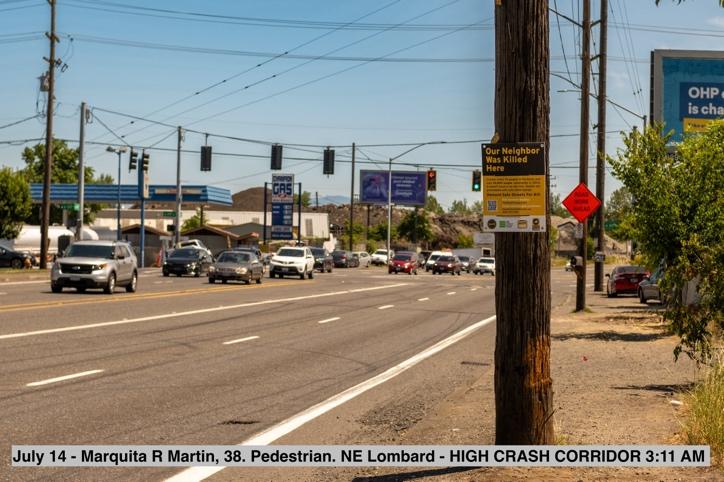
Words and images by Sarah Risser. Risser was a guest on the BikePortland Podcast back in March.
2023 was a devastating, record-setting year for road fatalities in Portland. 69 people were violently killed in a crash, the highest number in over three decades. The grim statistics elicited concern, but not nearly enough to rally the energy and resources needed to meaningfully address the problem. The United States has been immersed in a car-centric transportation culture for decades which has conditioned us to dismiss road-traffic violence as just something we have to live with, for many it is merely background noise. However, the normalization of road traffic violence is not grounds to for continued complacency and indifference. We know that almost all road fatalities are preventable, but that it will require hard tradeoffs and political will to effectively address the problem and create truly safe and livable streets.
My inspiration to place a sign at every fatal crash site came from a desire to help people see how widespread Portland’s road safety problem is and pay tribute to those who have made the ultimate sacrifice to our car-centric transportation system.
I thought if people saw more and more signs throughout the city, they might begin to understand the scope of the problem. I had a lot of help getting this project off the ground and would be remiss to not mention them: Families for Safe Streets Founder Amy Cohen generously paid for the signs and former BikeLoud PDX Chair Aaron Kuehn provided layout and design support along with fellow BikeLoud member Claire Vlach. BikeLoud also paid for zip-ties and other related expenses, and Oregon Walks was an all-around booster of the project.
I wasn’t able to share details on every fatality, but please understand they are all equally tragic and important in their own unique way. Those that have been highlighted are illustrative of other issues or proved to be more poignant for me personally as I placed the sign.
With that, below is my journal of a year placing signs at Portland’s fatal crash sites:
January 1st
My project, unfortunately, commenced immediately. At 10:00 pm on January 1st, 32-year-old Jesse Loyer rear-ended a vehicle stopped at a light on 82nd Ave with his new Harley Davidson motorcycle. Loyer left behind his wife Stacey and two small children, Judah James and baby River Rae. I felt compelled to visit the crash site early the next morning. When I arrived, the traffic was flowing like a torrential current, distracting me to such an extent that I wouldn’t have noticed the crash site unless I was looking for it. When I saw the red police tape, I made my way over and noted a pile of debris, some broken glass, and a single shoe. As I crouched down to take a picture, a young man in a large hoodie rounded the corner, hands in his pockets and shoulders slumped forward, with a bright, wide-eyed, little girl who stayed close by his side before hopping up on a bench to wait for her school bus — directly in front of the precise location where a man had been violently killed. Her school bus came shortly, and she climbed on board, blissfully unaware, I hope.
January 23rd
January 24th
January 26th
For an inspired example of a life well lived, check out Chuck Preisch’s obituary. Chuck moved to Portland from Cleveland to be closer to his kids where he did many things, including adding color to Portland’s food truck scene as the “Hot Dog Doctor.”
January 27th
I found a bouquet of flowers when I went to place a sign for Floyd William Charlan Jr. on SW Beaverton-Hillsdale Highway. A heavyset woman who looked to be in her 60s approached, interested in reading the sign. As she scanned the text, she became emotional, and thanked me for my concern and efforts. “This road is so dangerous,” she said, shaking her head, “people drive way too fast.” She told me her neighbors were upset but not surprised. “Everyone is bothered by how busy the street is, and how hard it is to cross,” she said, “we were all expecting a tragedy such as this.” The woman told me that she takes care of her little granddaughter a couple of days a week. Her daughter rents a smaller, older, more expensive unit a few blocks away, because she refuses to raise her child beside such a busy, noisy, dangerous road.
February 4th
February 5th
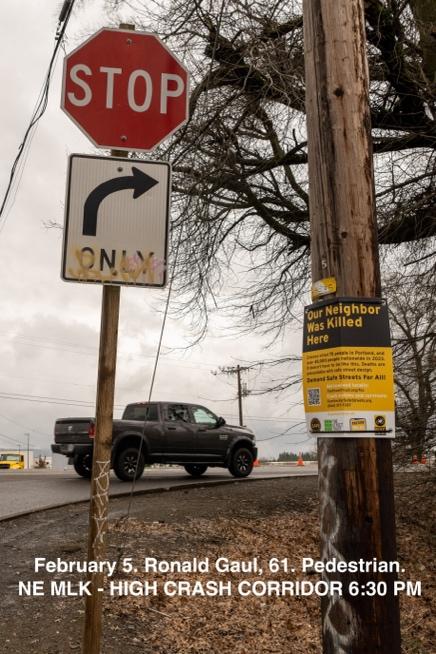
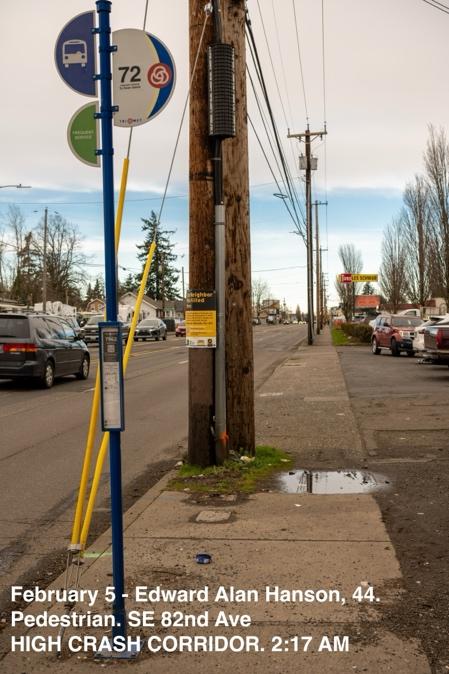
February 7th
District 4 has the fewest crashes in the city of Portland, which is surprising given the dearth of sidewalks and bike lanes. Many of the roads throughout SW Portland wind and curve with limited visibility and narrow or nonexistent shoulders.
Peter Pellegrin was riding his scooter when he was involved in a crash with a vehicle just a few blocks from his home. The sign we placed was not comforting to his family. Rather it was a constant and unpleasant reminder of their loss which exacerbated feelings of grief and evoked valid anger toward this sign project for potentially politicizing a fatality. The sign was removed immediately. The family also requested PBOT remove their digital signage, a request that was also respected.
February 9th

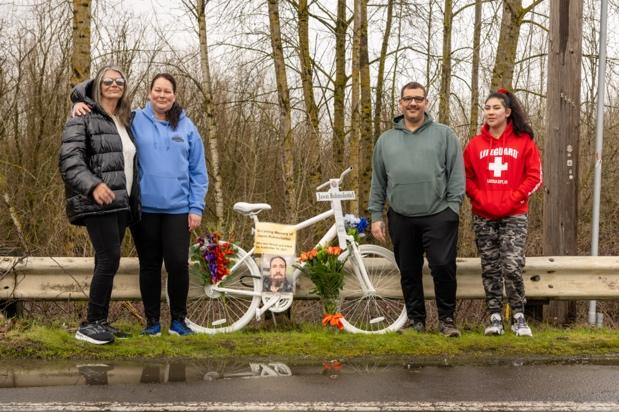

Community members gathered on North Portland Road to install a Ghost Bike for Jason Ruhmshottel (the sole cyclist fatality of 2023) at the request of his family. I was an honored and privileged to work on this and be present with Jason’s family for the installation. Brian Davies at the Community Cycling Center provided a bike, which I scrubbed down before applying multiple layers of white spray paint to over the course of many days.
In addition to Jason’s family, a number of community members showed up for the installation. The family wanted it placed where Jason’s body had landed after he was hit. We locked the bike in place as semis and trucks sped by. The family adorned the bike with flowers to beautiful effect.
Roadside memorials are important for many reasons. They draw attention to dangerous roads, honor victims, and often provide comfort for the family. Many, including me, see them as heartfelt folk art. I was able to visit Jason’s ghost bike again in early November. I was impressed, after seeing Jason’s bike it decorated for Halloween in such a happy way, by how loved Jason is and how important his ghost bike is for the family’s ability to honor and grieve.
February 10th
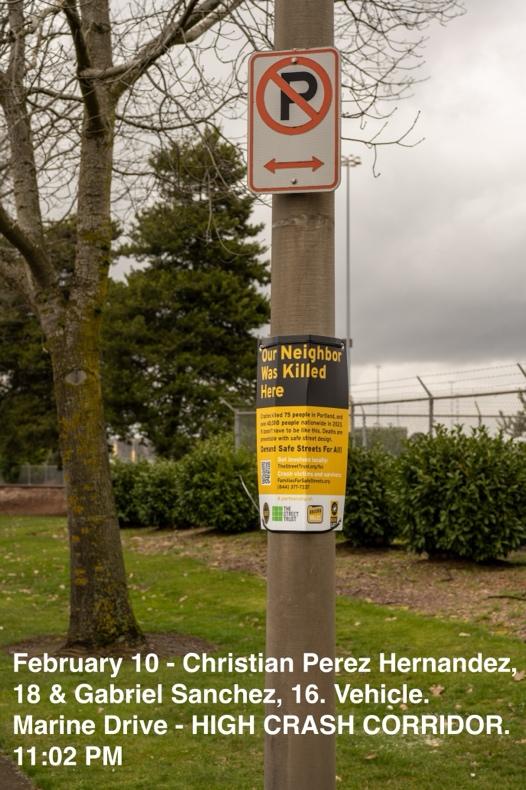
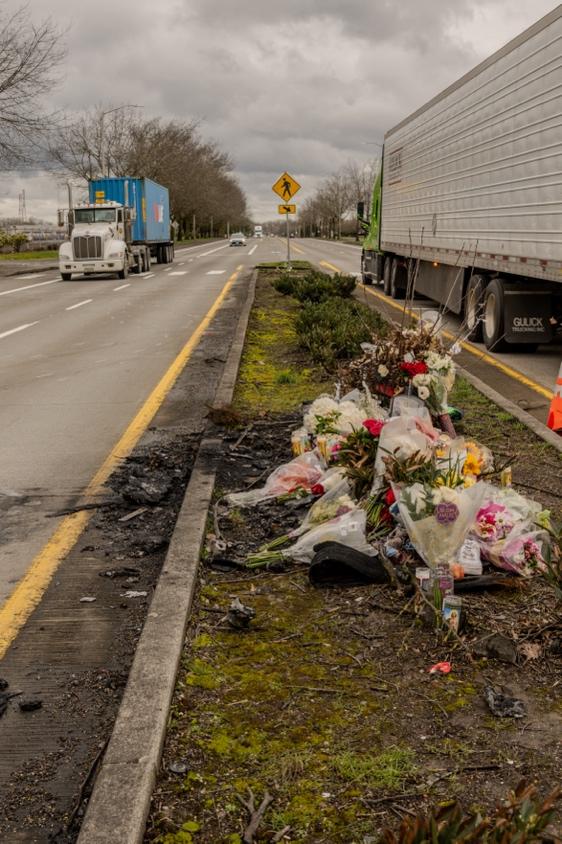

Christian Perez Hernandez and his friend Gabriel Sanchez were street racing when they crashed and their vehicle went up in flames. I was struck by the stark contrast between the charred outline of their vehicle with the delicate bouquets left for the boys at the crash site.
Given that we know speed is a factor in nearly 30% of all crashes and that young men are more likely to engage in risky behavior, I question why the auto industry is allowed to manufacture and flood our world with vehicles capable of achieving, unnecessarily deadly speeds. This year Families for Safe Streets and the Vision Zero Network sent strong communications to Gavin Newsom encouraging him to support CA SB961, a landmark bill that would require Intelligent Speed Assist in all new vehicles manufactured or sold in CA beginning in 2030. A win in California would send a strong signal to Auto Manufacturers. Unfortunately, Governor Newsom vetoed the bill after it passed both the State Senate and Assembly and garnered considerable nationwide support.
February 10th
An intoxicated driver hit the car Wael Zahran and his friends were in, pinning him in the back seat. Zahran, 23, died after being transferred to the hospital. Zahran’s mother, who doesn’t live in the United States, was unable to attend her son’s funeral, which happened to be held on his birthday. His friend, Nariman Mosharaf was severely injured in the crash, suffering a brain bleed, concussion, and a punctured liver which required surgery. In addition to his suite of life-altering injuries, Nariman was left with a pile of medical bills that he didn’t have the resources to pay. His friend organized a GoFundMe to help. It’s crucially important, when calculating the full cost of road violence, to include the many crashes that leave victims with debilitating injuries and financial burdens. Insurance so often doesn’t cover the full costs associated with a crash and the victim is often left holding the bag. Many who survive a crash, such as ‘Nari’ are unable to work as they recover, compounding the financial burdens and stress.
February 14th
By the time Jeremy Bankston, 38, was killed, year-to-date fatal crashes in Portland were tracking higher than 2023. Thomas Shults of KGW8 News reached out to see if I would talk on behalf of Families for Safe Streets. I suggested we meet me at Bankston’s crash site where I intended to put up a sign. Coincidentally Bankston’s family and I arrived at the very residential site in NE at the same time. The family was there to place flowers on what looked like private property and grieve. They appreciated the sign and thanked me saying they agree that we need to raise awareness about how dangerous traffic is. They were too shaken to speak with the television reporter. ‘I can’t do it,’ Bankston’s sister said, ‘I’d burst into tears in front of the camera.’ As part of his coverage, Shults also interviewed ODOT Spokesperson Don Hamilton who attributed Portland’s road fatality problem largely to an increase in irresponsible, reckless driving.
February 23th
February 25th
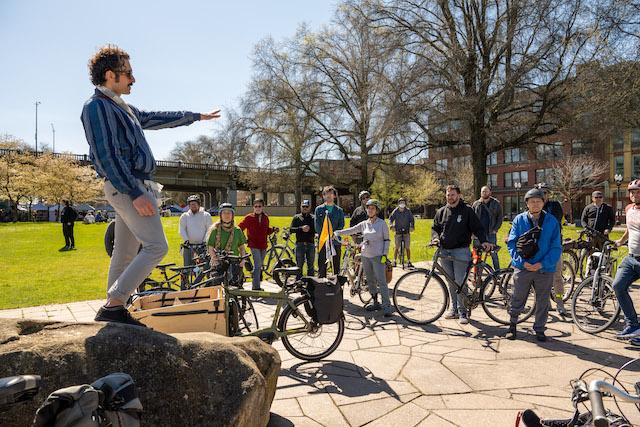
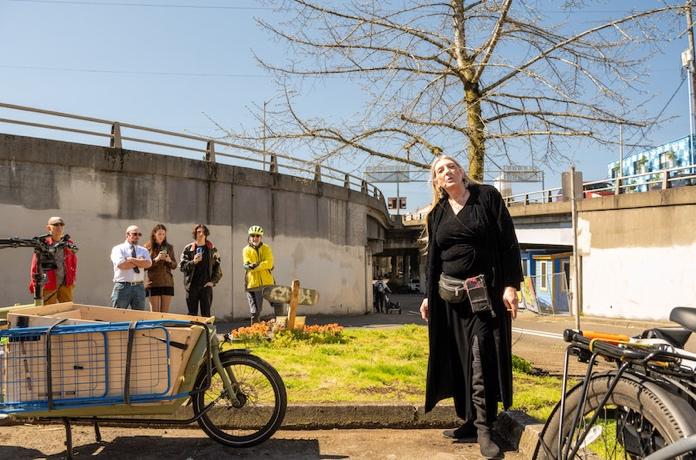
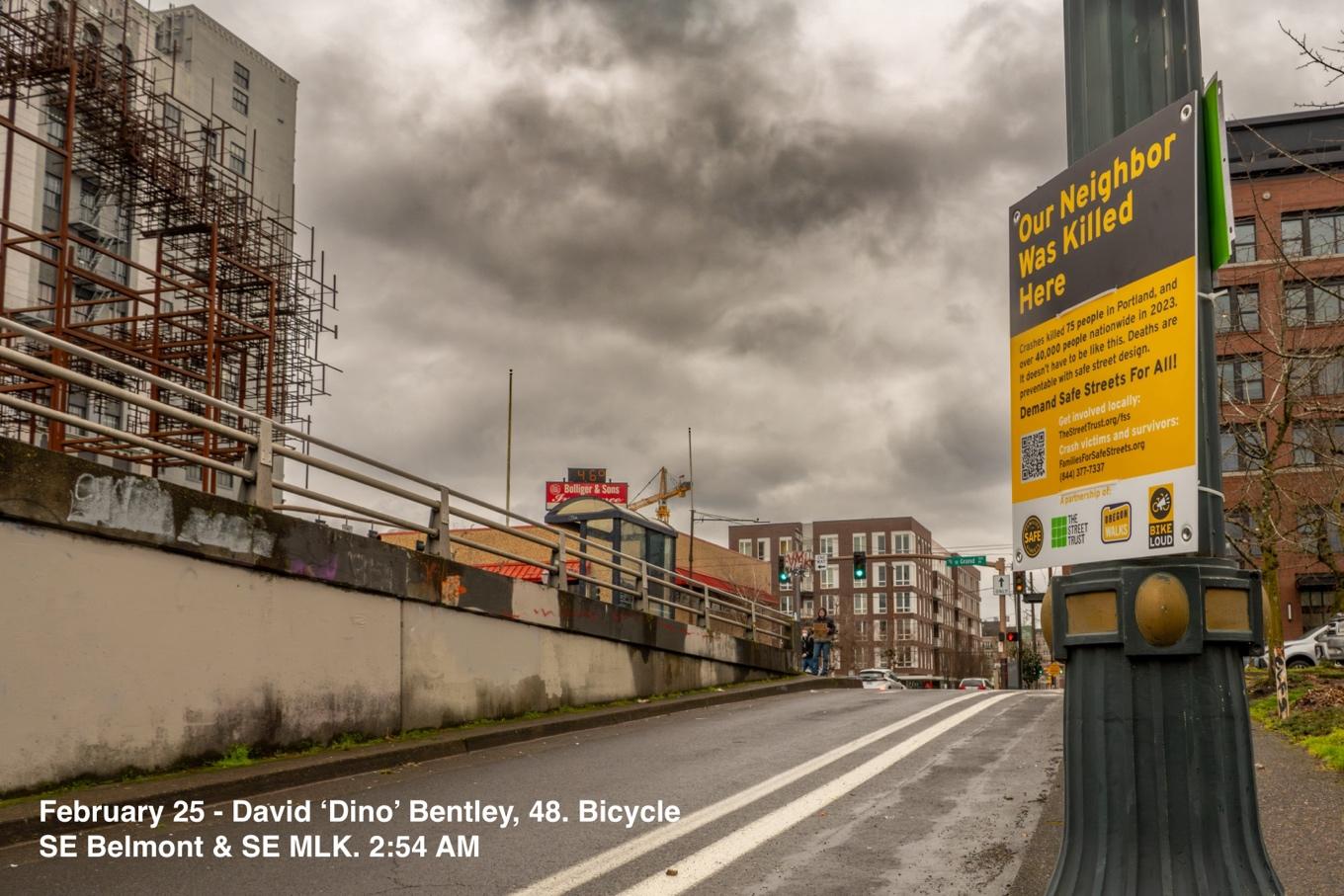
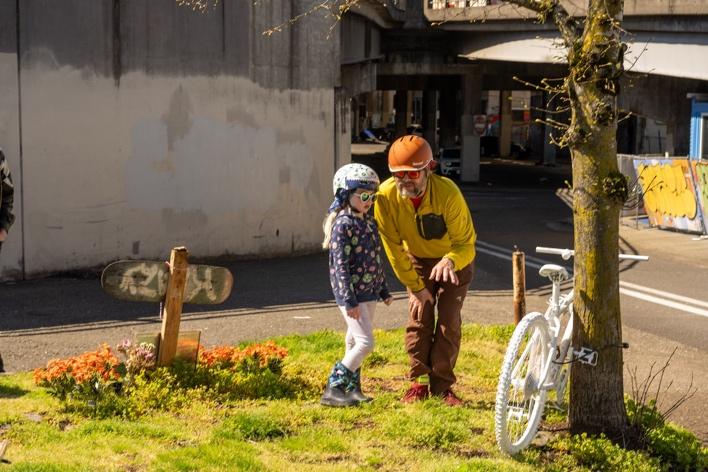
This fatality is not considered or counted as a road fatality by the city of Portland, because the at-fault driver, using his Chevy Malibu as a weapon, intentionally sped up and hit Bentley early in the morning on February 25th. Portland does not include homicides or suicides in their official tally of road fatalities and this, by all accounts, was a homicide. It was the first instance in 2024 (in Portland) where a vehicle was used intentionally as a weapon to kill.
Later that spring on March 30, the community showed up to honor Bentley by installing a ghost bike at the crash site. Claire Vlach and Hami Ramani led a ride from Tom McCall Park where a large group had gathered. David’s mother arrived on a Lyft Scooter just before the ride commenced. The group rode to the crash site where several people spoke, including Claire, David’s mother, and a number of David’s friends. I had placed a sign earlier which had been removed. With help from Hami Ramini, Joe Perez, and Shawne Martinez, we placed it higher.
March 12th
March 20th
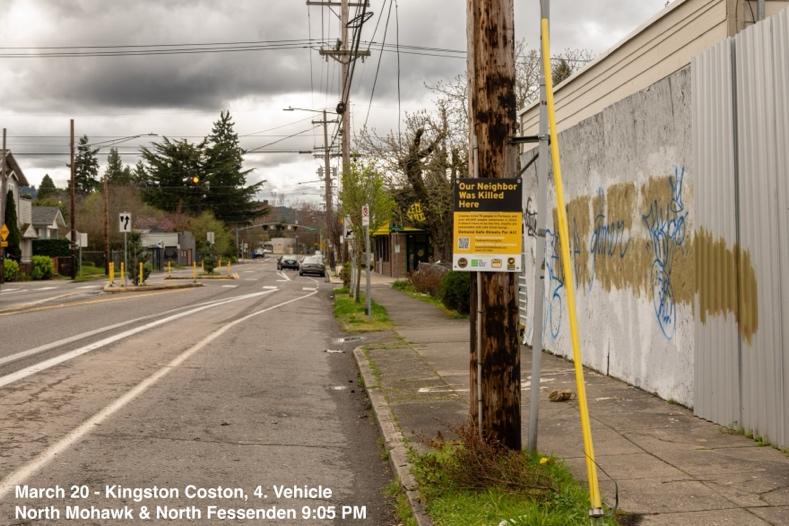
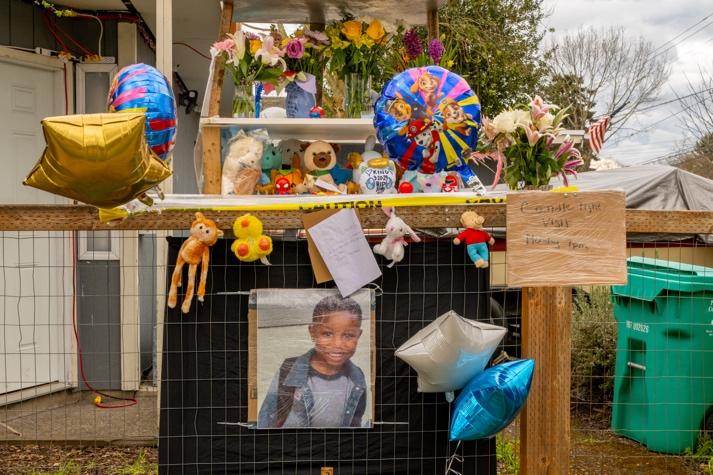
2024’s youngest road traffic victim, four-year-old Kingston Coston, was killed in the back seat of the vehicle his mother was driving while speeding and under the influence of alcohol. I don’t mention this to shame his mother, who will never recover from this tragedy. In truth, my heart goes out to her. We have not addressed DUI in anything close to a rational or rigorous way. It is misguided in my opinion to expect people impaired by alcohol to make logical decisions their ability to drive safely. This approach has never worked and never will. Moreover, we have tolerated a transportation system so deadly that tens of thousands of Americans unintentionally kill other road users every year.
We have the technology to prevent vehicles from starting should the driver be under the influence of alcohol and we badly need the political will to demand that it is installed in every new vehicle. NHTSA has initiated steps to integrate drunk driving prevention technology into new cars as a standard feature, but there is resistance. BikeLoud and Families for Safe Streets submitted a comment in favor of this requirement just days before the crash that claimed Kingston’s life.
April 2nd

April 8th
May 4th
May 29th
June 3rd
June 6th
June 14th
June 25th
Three young men were driving a stolen vehicle (although it seems police didn’t realize the vehicle had been stolen until after the deadly crash occurred), when, according to KGW, Gresham Police attempted to stop Jayden Rolon-Ekis, who was behind the wheel with two friends in the car. A chase ensued. Before hitting a utility pole that knocked out power, Rolon-Ekis hit another vehicle.
The costs of police chases are astronomical and, in my opinion, unacceptable. One speeding vehicle poses a danger to the community. When officers willfully engage in a chase they are increasing the danger twofold, and possible more by incentivizing even faster driving in the vehicle they are pursuing.
Dylan and Jayden had been sophomores at Ida B Wells before recently transferring to Portland Community College. They both died at the scene. Cole succumbed to his injuries within two weeks. The human brain is not fully developed until age 25, and teenaged males are prone to risky and impulsive behaviors. It is also true, that speed is a factor in over 30% of all fatal crashes; speed contributes disproportionately to kinetic energy, which is the cause of all fatal and serious injuries.
July 11th
July 14th
July 25th
August 2nd
Malcom Braman and Nicholas McGuire lost their lives evading Gresham police officers. The Gresham and Portland police had joined forces to break up the West Coast Invitational, a street takeover event. In a press briefing, Portland Police emphasized that the event would attract young, inexperienced, drivers, presumably the type that is likely to crash when driving recklessly at high speeds. During the multi-agency response, Gresham officers tried to pull Braman over for speeding, but Braman fled the scene. The Gresham Police began an intense pursuit which involved the Portland Air Support Unit and additional officers to deploy spike strips.
The irony here is stark: The police exacerbated danger to themselves, the fleeing vehicle, and the general public by engaging in a deadly chase with a driver they knew with near certainty to be young, inexperienced, and likely to crash. Braman crashed into a utility pole at NE 122nd and Marx, rolled his car, and died at the scene. McGuire was transported to the hospital where he later died of his injuries. Had the Gresham police not engaged in a reckless pursuit these two men would likely be alive.
August 5th
August 7th
August 15th
August 16th
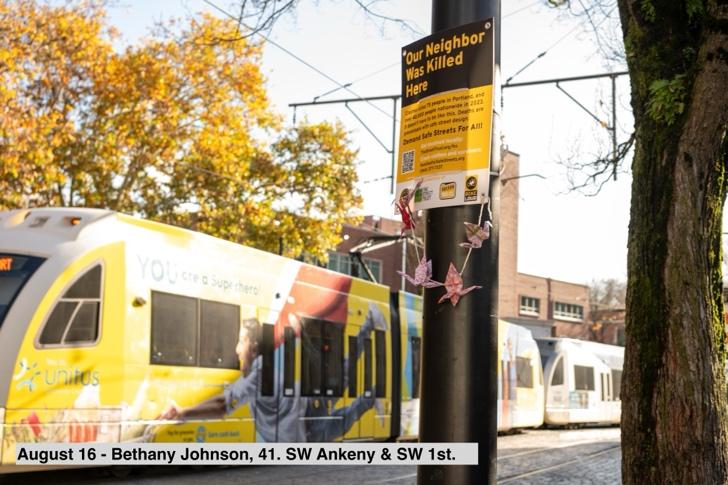
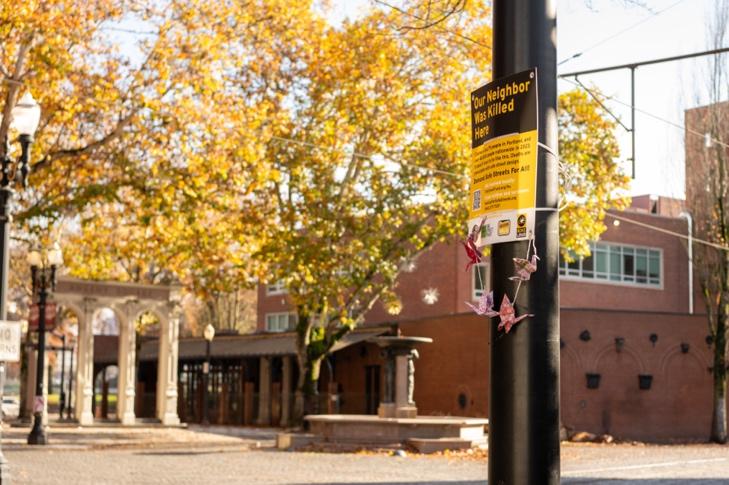
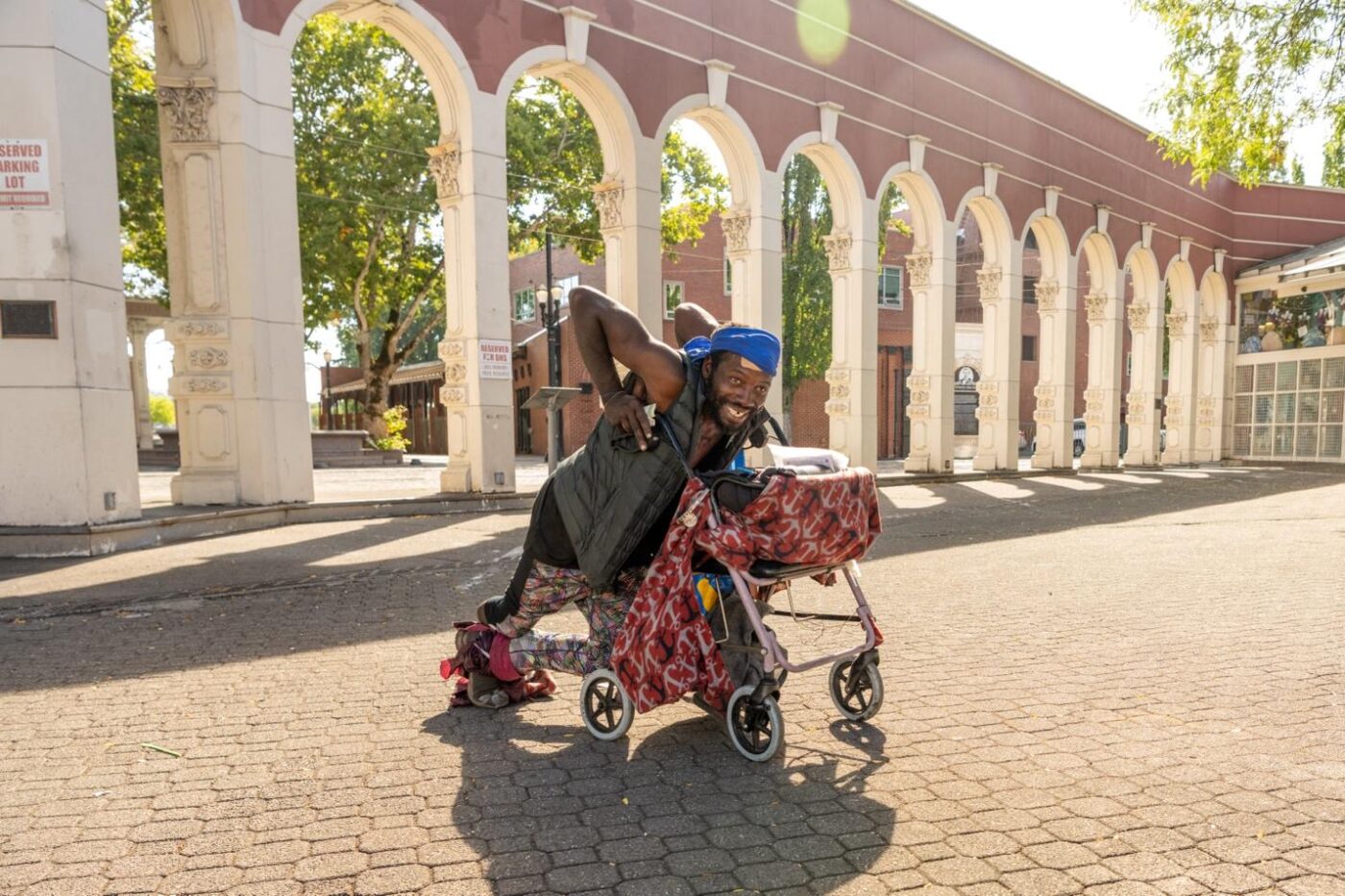
When I arrived at Ankeny Plaza, I was charmed and distracted in a way that felt inappropriate. I was here to honor a life lost in road traffic, but there was so much to take in and learn about the history of Portland at this site. I wandered about the plaza taking photos of the arches, until an unhoused man hopping behind a walker approached. He had lost part of his right leg and had tied a colorful swath of fleece fabric to his left ankle, which trailed behind him like a tail. His smile drew me to him, and we talked for a while. He told me his leg had to be partially amputated after he sustained a severe case of frostbite in last winter’s ice storm, but that he doesn’t miss his lost limb. He said he likes his leg better now because it doesn’t get in the way if he wants to swing it around and do tricks. He leaned forward, engaging his sculpted arm muscles, and swung his amputated limb up and over his walker, beaming. He let me take his picture, which I treasure.
This was, without question, the most beautiful crash site I’ve ever visited. I came back later to hang a string of paper cranes to mark the starting point for Oregon Walks’ guided walk to the World Day of Remembrance at City Hall.
September 4th
September 18th
September 20th
September 27th
October 18th
October 21st
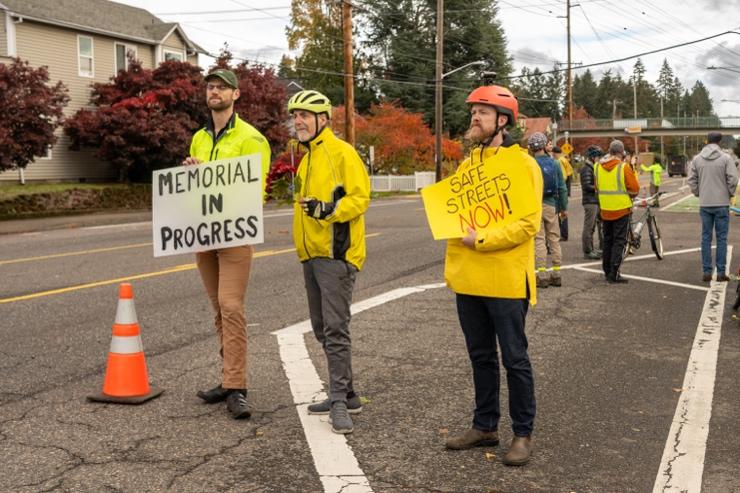
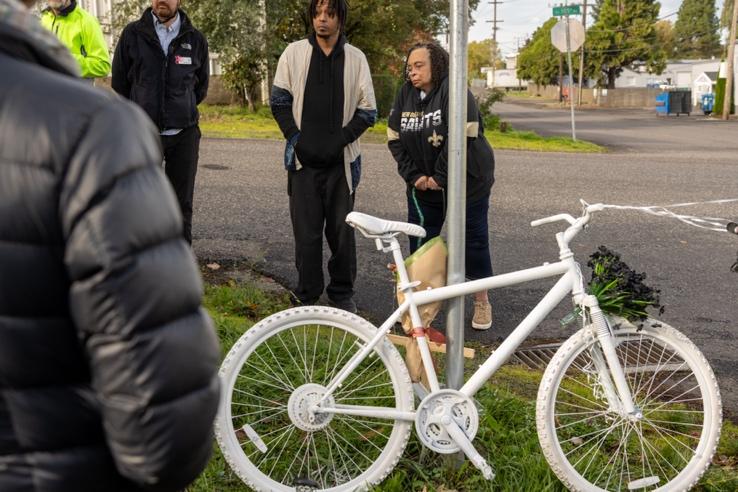
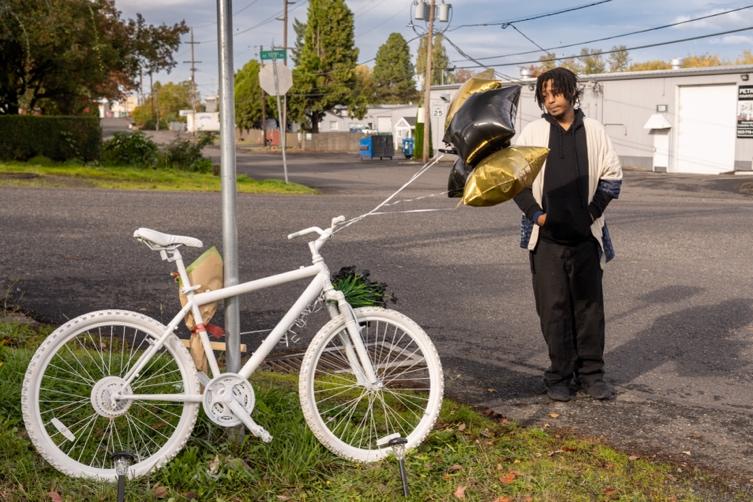
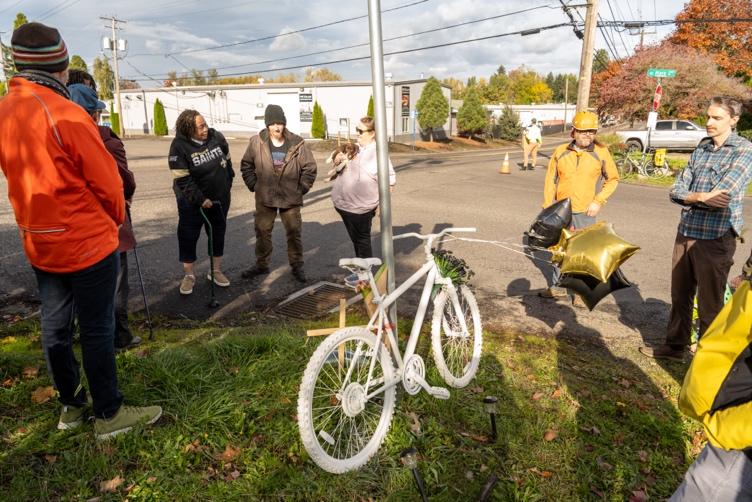

When a cyclist is killed in Portland, it hits the community hard. It didn’t take long for the news to start to circulate on the morning of October 21 that a male cyclist had been killed at NE Glisan and 128th, directly in front of Menlo Park Elementary School at 2:37 AM. BikePortland had an article on the incident posted by 7:37 AM, exactly five hours after the crash. Messages began flying around the BikeLoud slack channel. Yes, a vigil was in order, but how important was the timing? Should we gather immediately or wait to get elected leaders involved? How important was it to know who, exactly, was killed, where it happened, and why it happened? As the cycling community wrestled with these questions news of a second cyclist fatality broke. At 9:00 a.m. that same day, just 3.4 miles north of the first crash, at NE Marx and 105th, another young man had been killed. Yes, a vigil was in order.
In the days that followed, BikePortland provided extensive coverage of the two crashes, although there were official gaps in information including the names of the victims. This coverage was initially upsetting for the mother of the cyclist killed at NE Marx. She posted a comment asking the community to respect the family’s privacy and pointing out that the attention is disrespectful to those experiencing grief. How could any of us understand exactly what the family was going through and how coverage of their personal tragedy would land? The last thing we wanted to do was upset the family, who was undoubtedly in a state of shock and profound grief.
BikeLoud and Families for Safe Streets decided to hold a silent vigil for Damon Cousins, the NE Marx victim, to respect the family to the extent possible and not come across as politicizing the tragedy. News of the vigil was posted on BikePortland, which momentarily exacerbated Damon Cousin’s mother’s frustration. When she learned that the community just wanted to honor her son she opened up to the idea. Not only was she fine with it, she wanted to be there.
I showed up early with Damon’s ghost bike and talked with Damon’s mom. I felt profoundly moved as she showed me a picture of Damon on her cell phone. The image was striking in its strength and beauty. She shared other things about Damon – what sports teams he cheered for, what he loved to do, that he had a quiet, unassuming personality. Together we affixed balloons and lights to the bike as a few more single cyclists arrived. We began to gather in silence. Shortly a group of cyclists appeared cresting the hill in a long line and gliding down to the intersection in silence. I could see Damon’s mother’s eyes well up with tears.
We stood mostly in silence. A few people said a few words. BikeLoud volunteer Steve Cheseborough played music on his harmonica. Our collective hearts ached. We offered the family what we could, which wasn’t nearly enough – we showed up and stood with the family and tried our best to convey how much we cared.
People then rode to NE Glisan and 128th where Sergio Hunt was killed, and held a second vigil. At this site a few people spoke on the importance of addressing Portland’s road fatality crisis.
October 24th
October 28th
November 1st

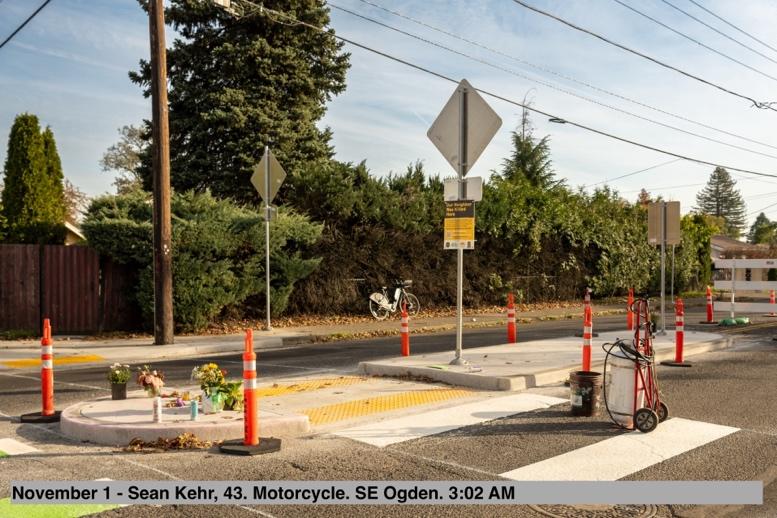
November 6th
I wasn’t able to place a sign at every 2024 fatal crash site in Portland. I chose not to place signs on the highway and the last few sites of the year are still outstanding. In some ways this project felt like an effort, but only in terms of physically getting to the sites. Once I arrived, I felt a sense of privilege to honor the victim and a sense of purpose that I was drawing attention to how unsafe Portland’s roads are. This project has also been about letting the family and community know that people care, that the victims are seen, and that many groups and individuals are working to make our roads safer for everyone.
I intend to keep putting up signs throughout 2025. If you’d like to be involved, please contact me at sarah.risser@gmail.com.


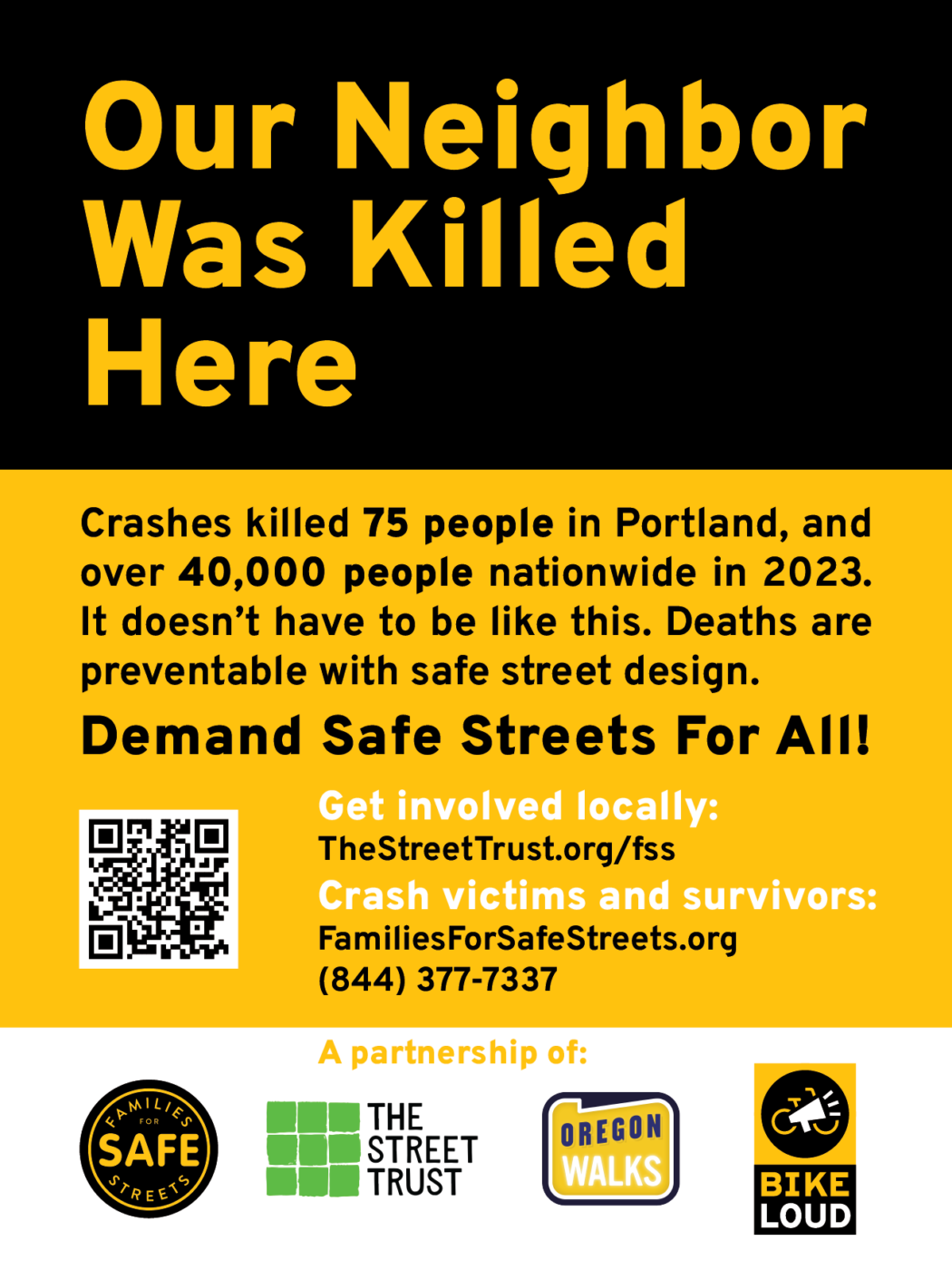
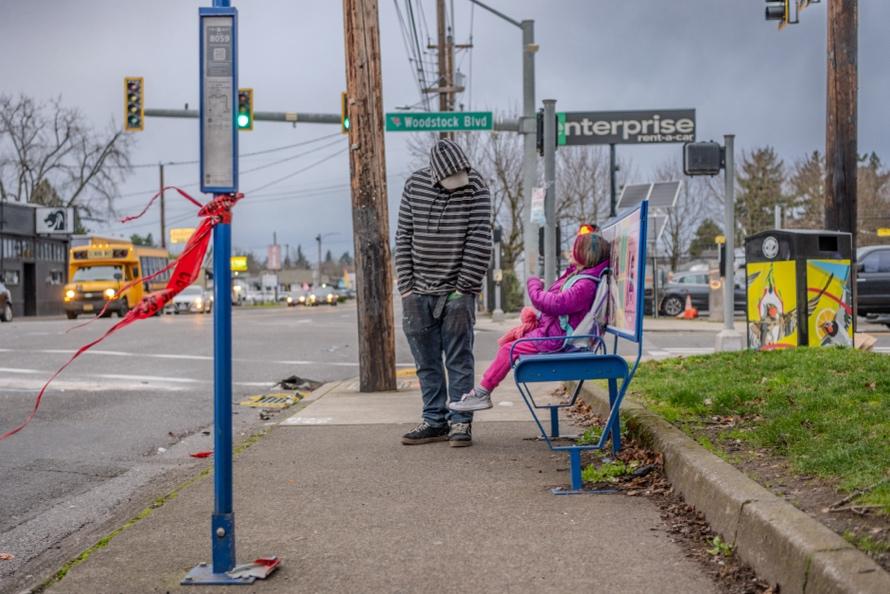
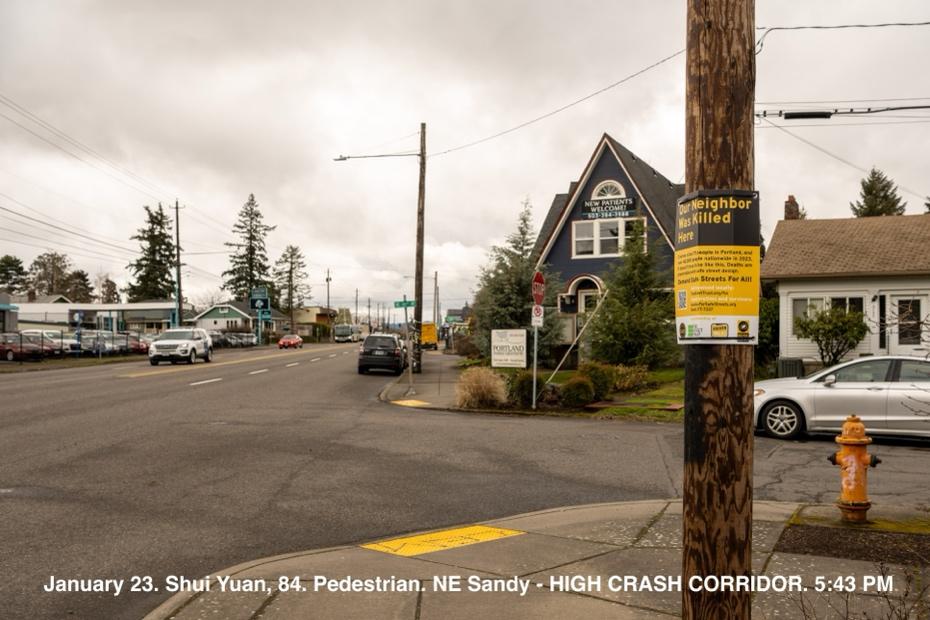
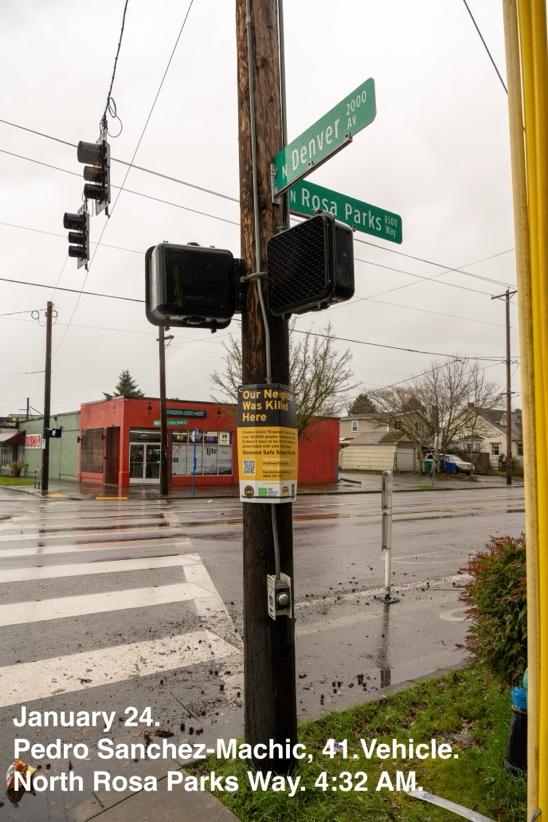
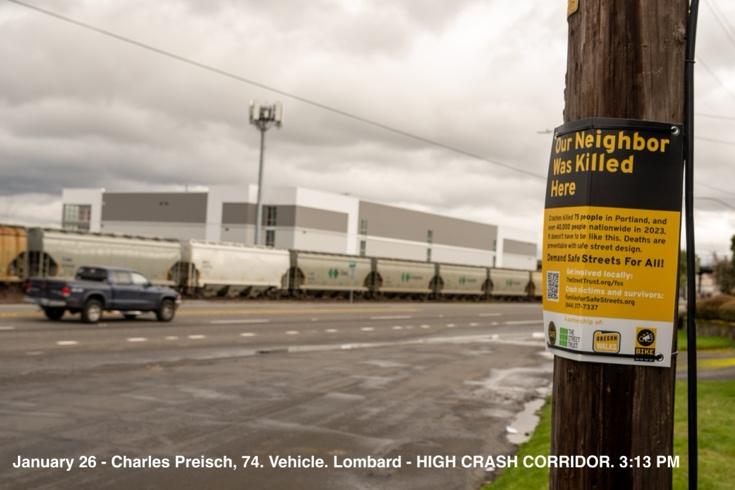
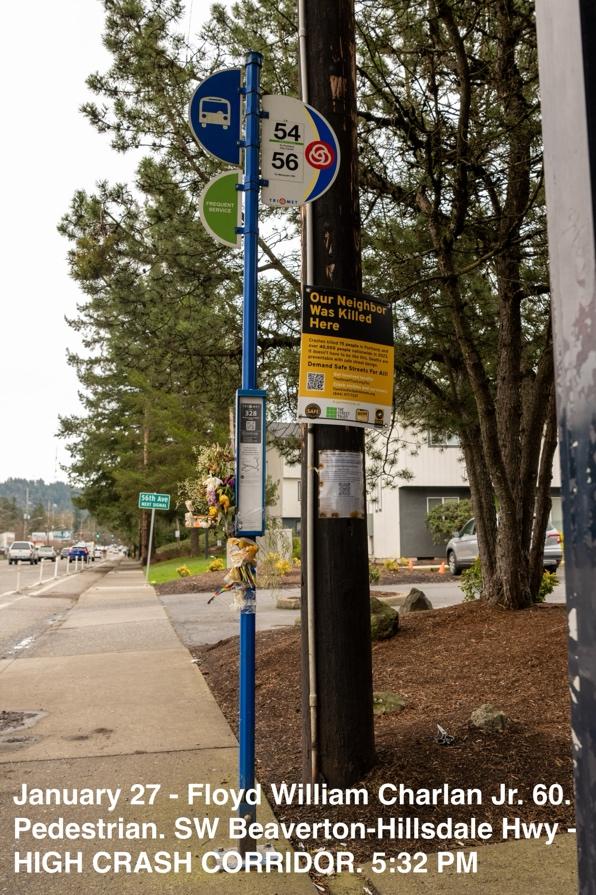

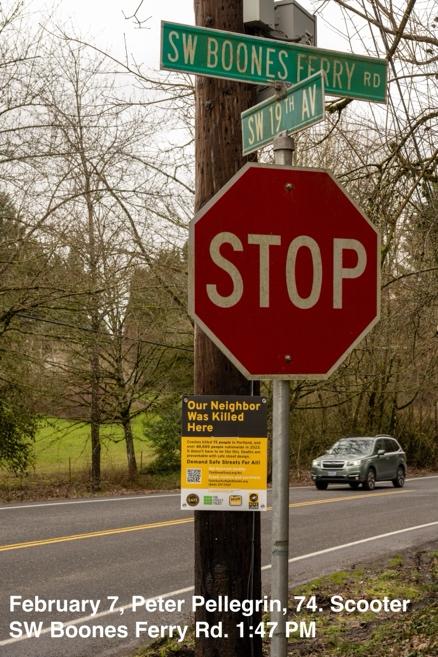

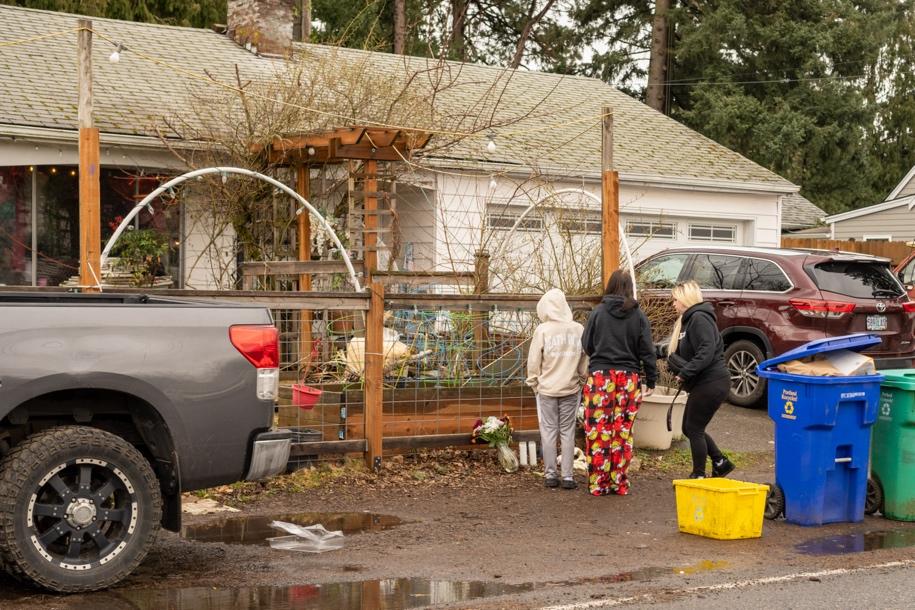
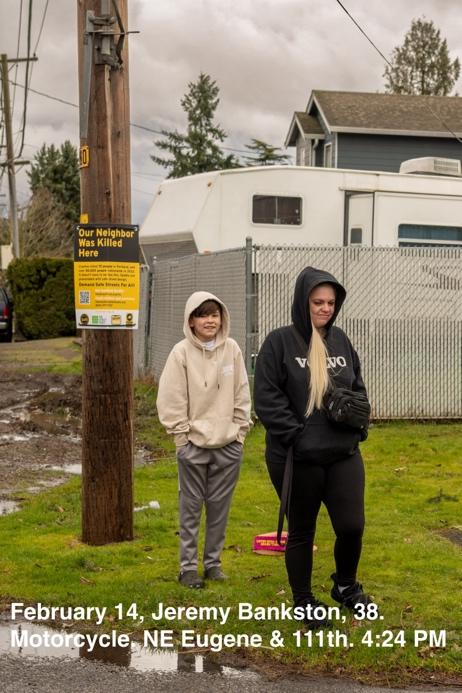
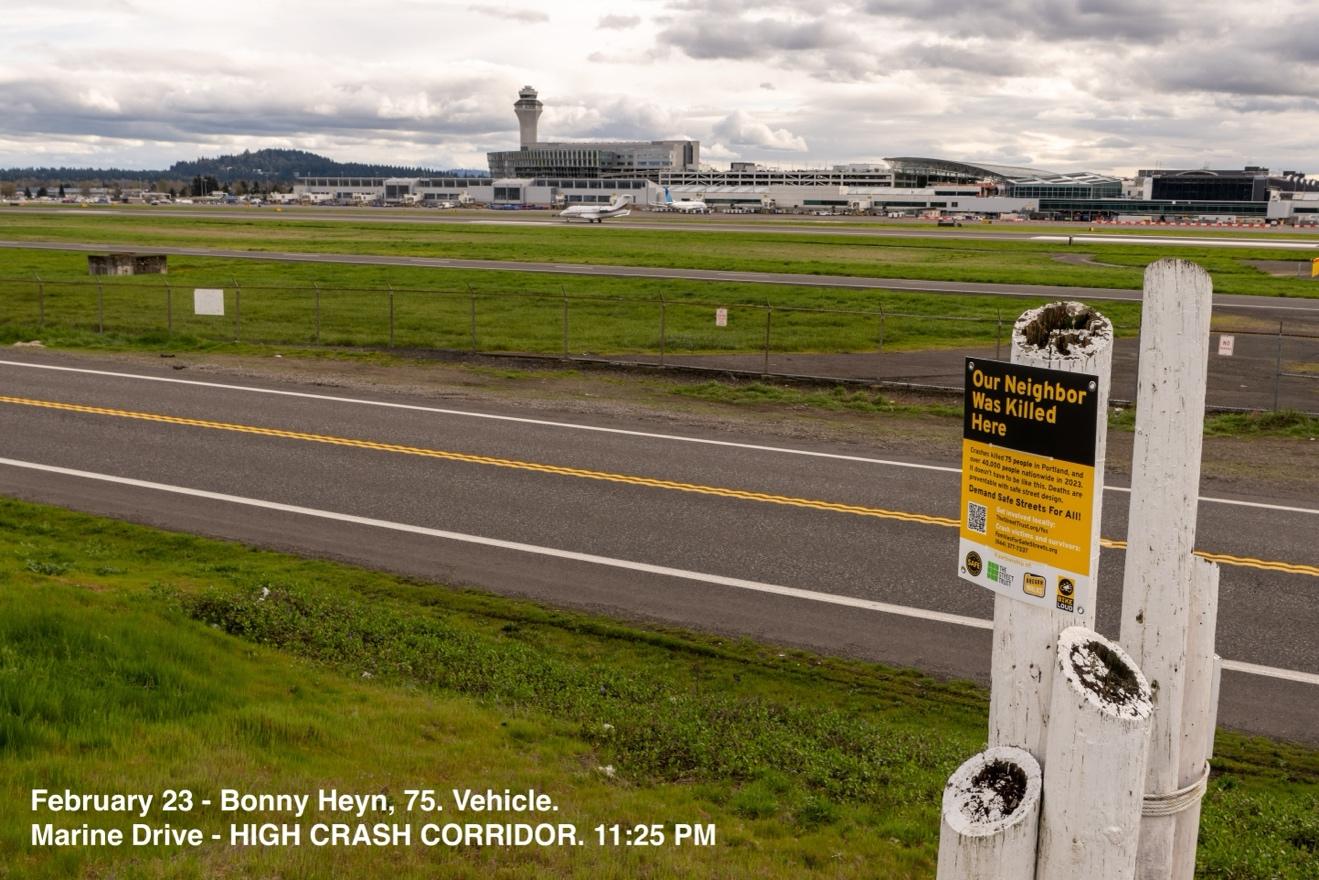
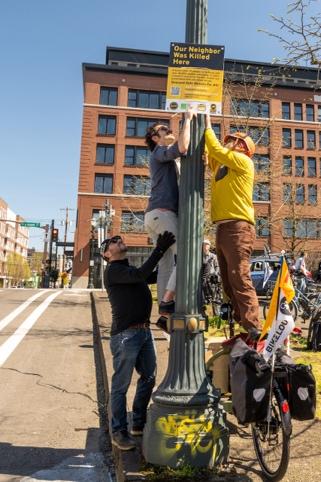



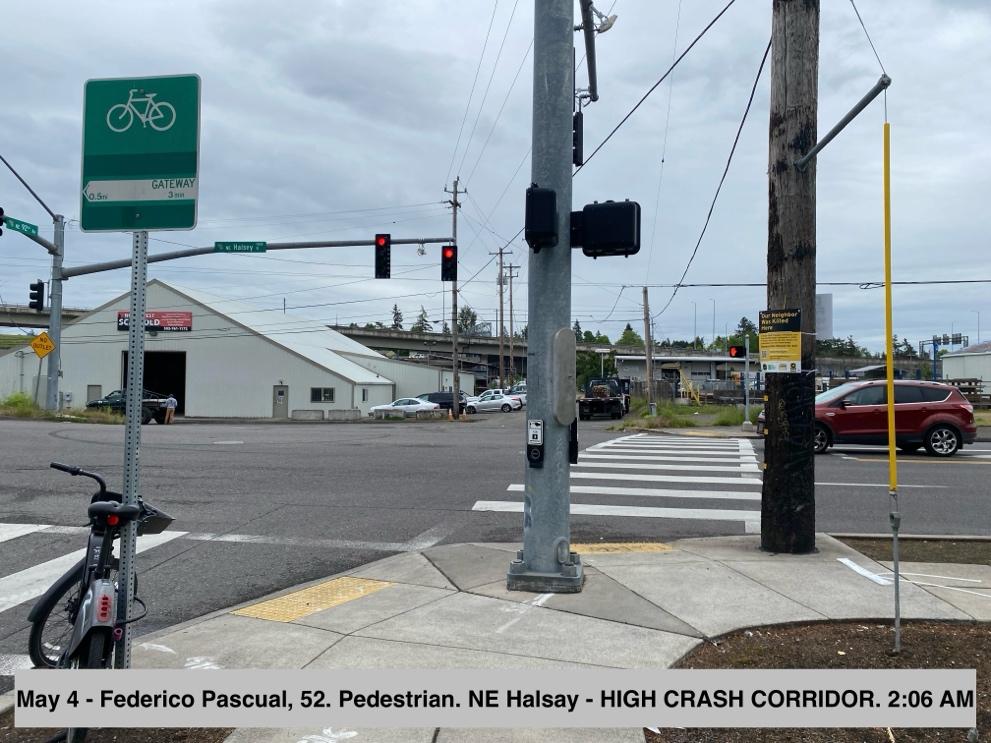
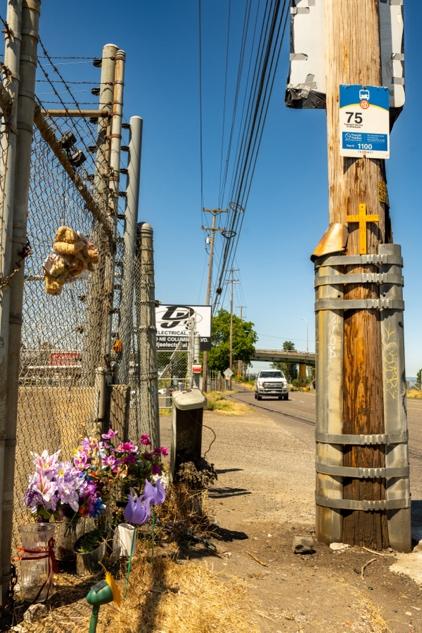
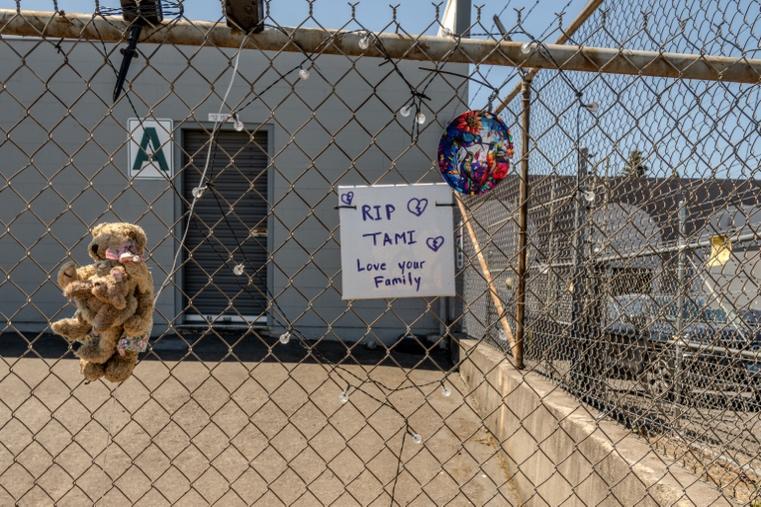

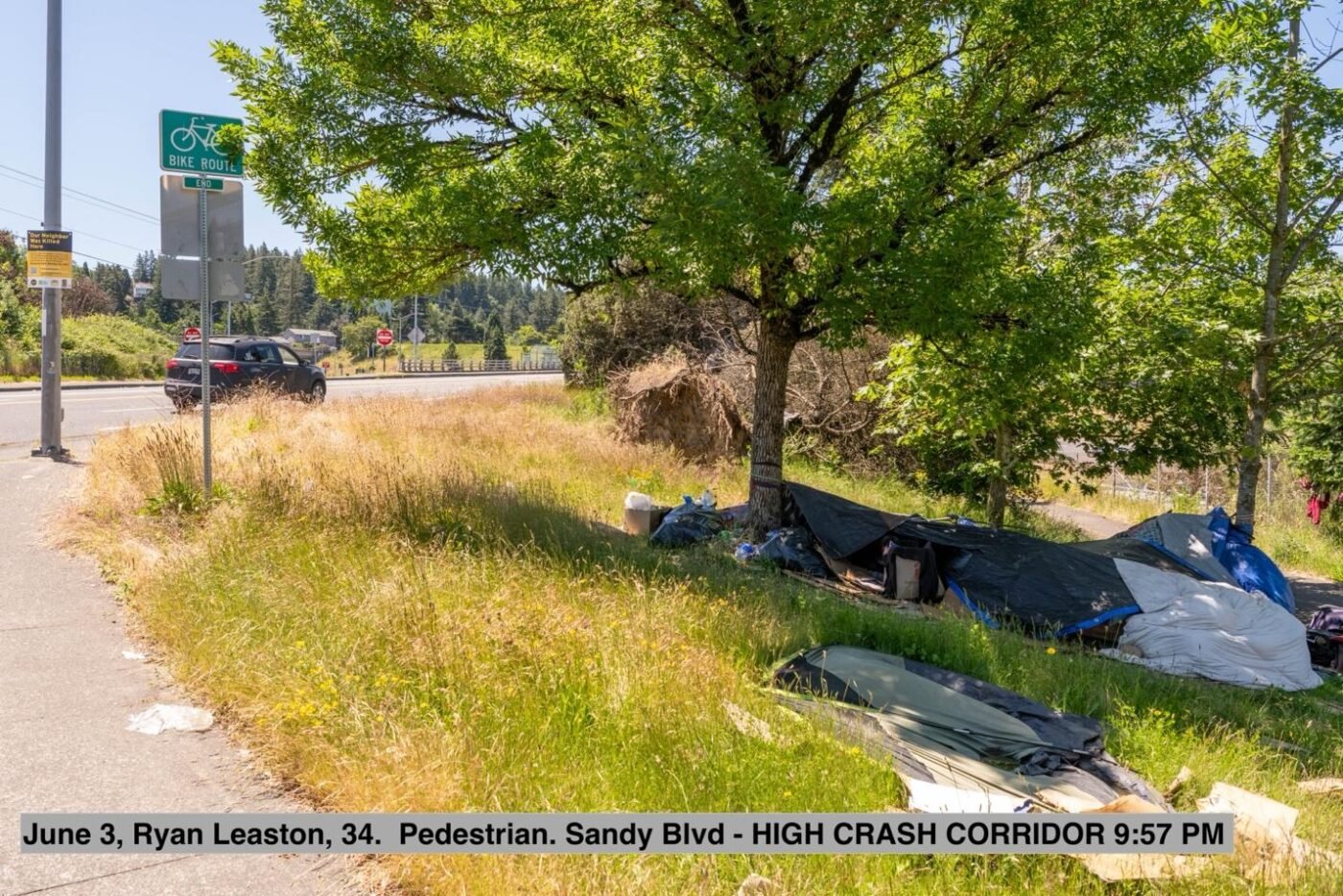
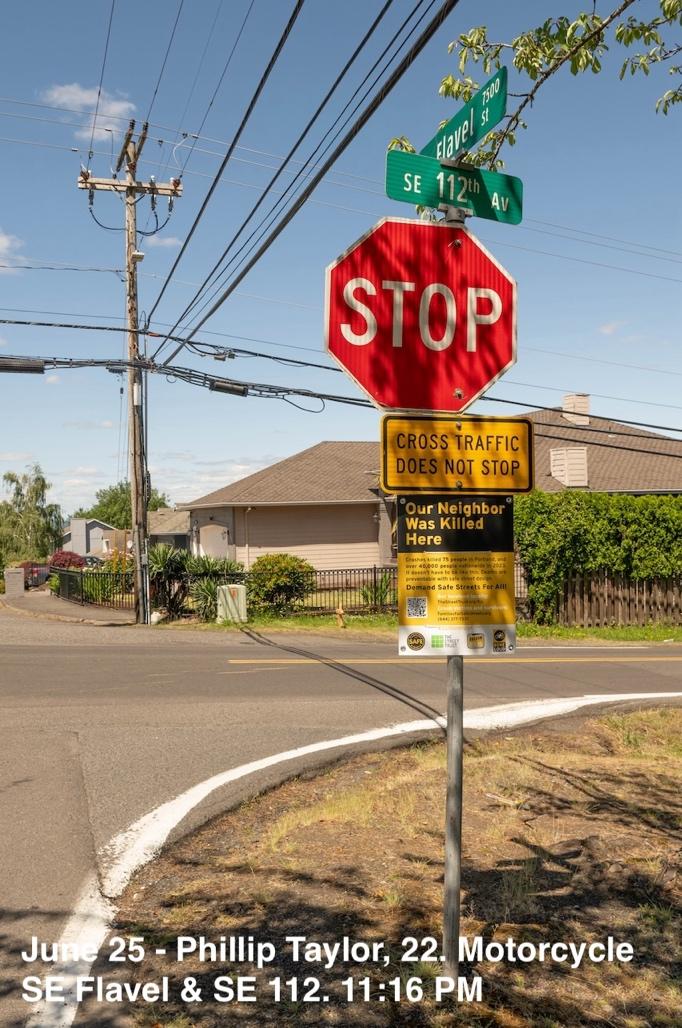
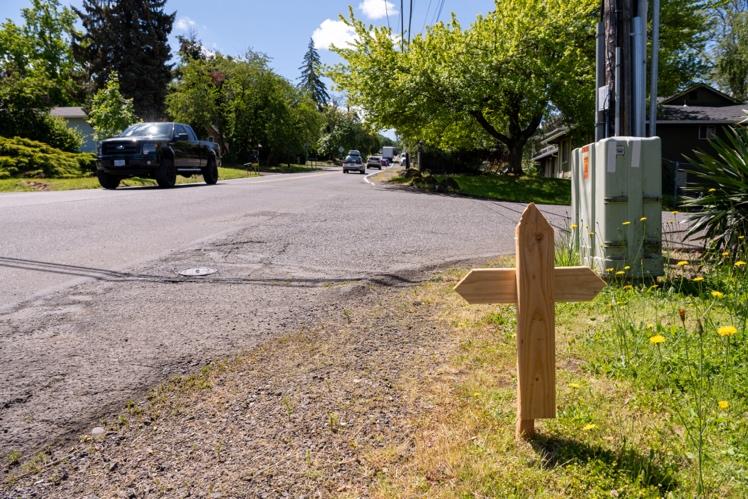

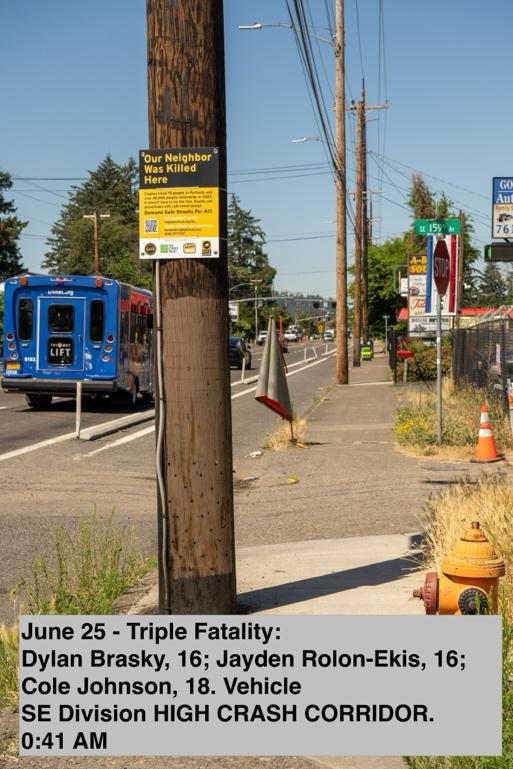

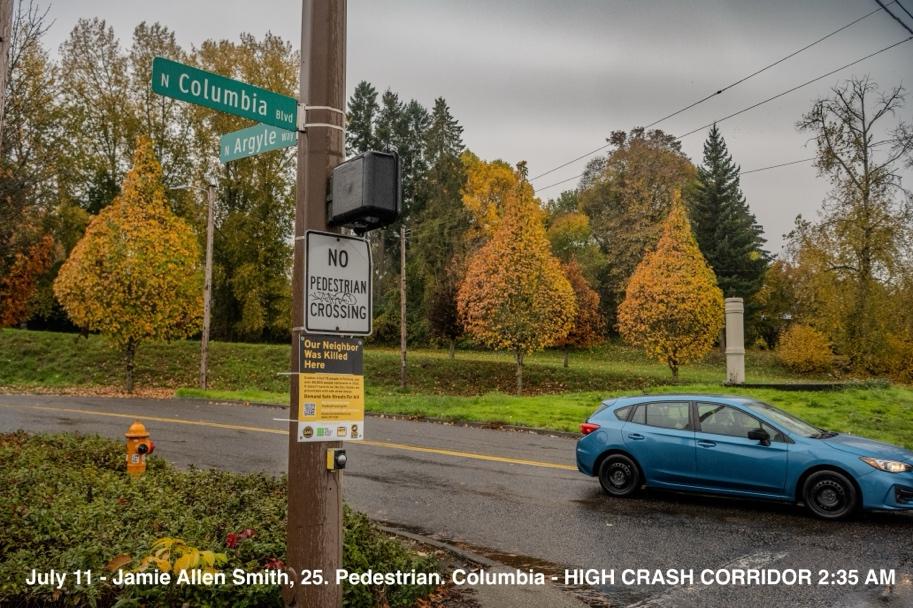

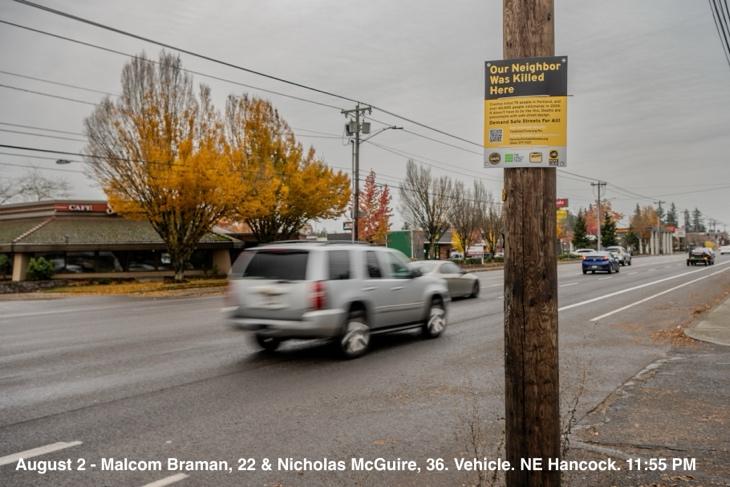
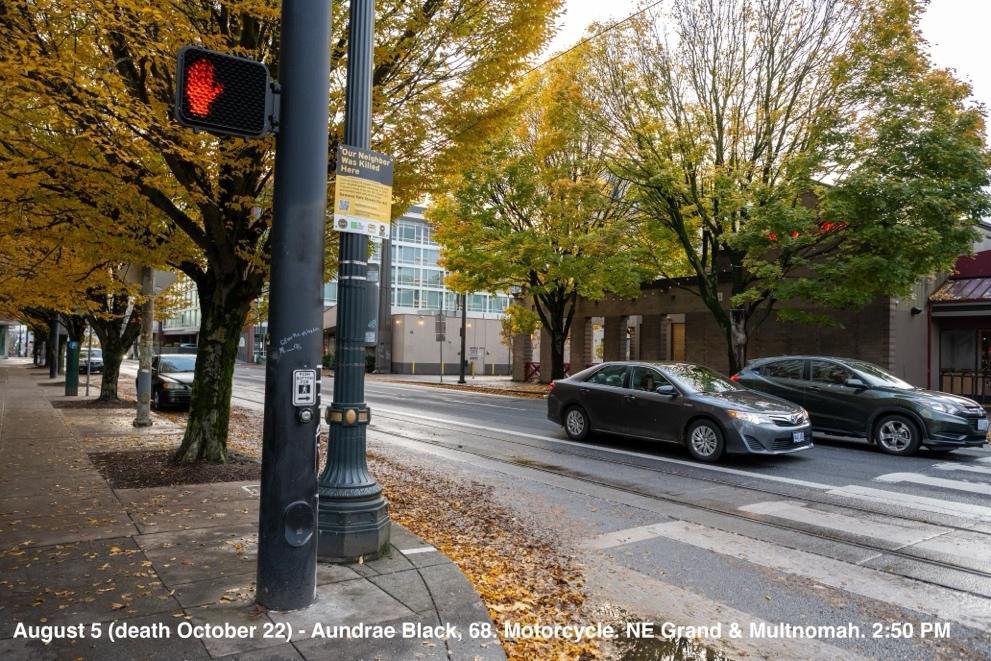
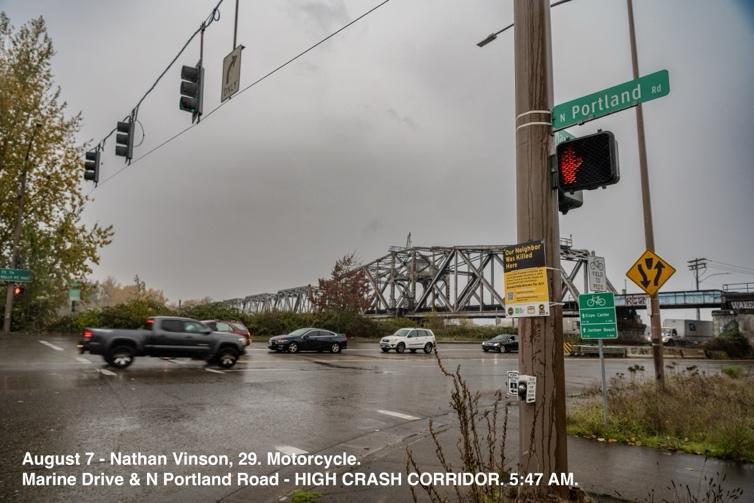
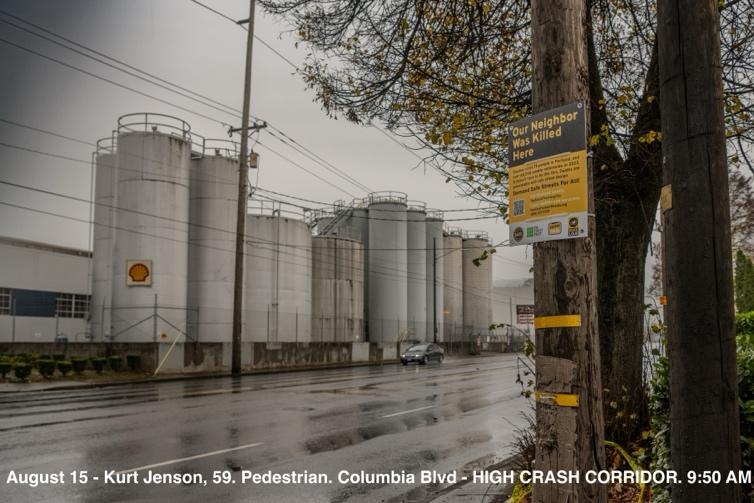
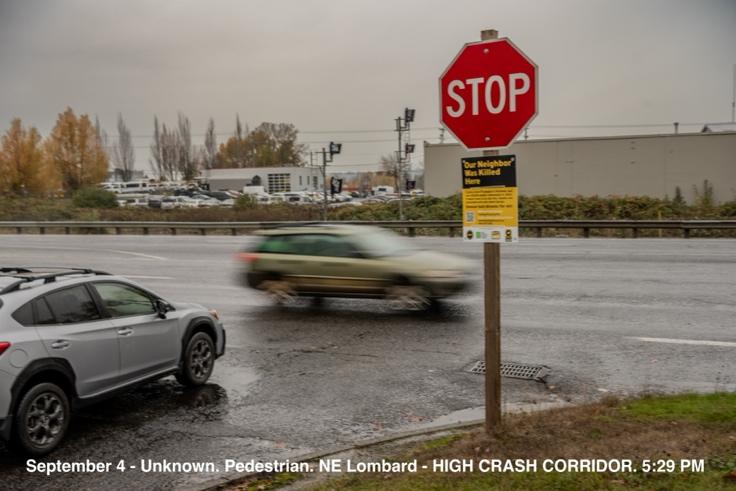
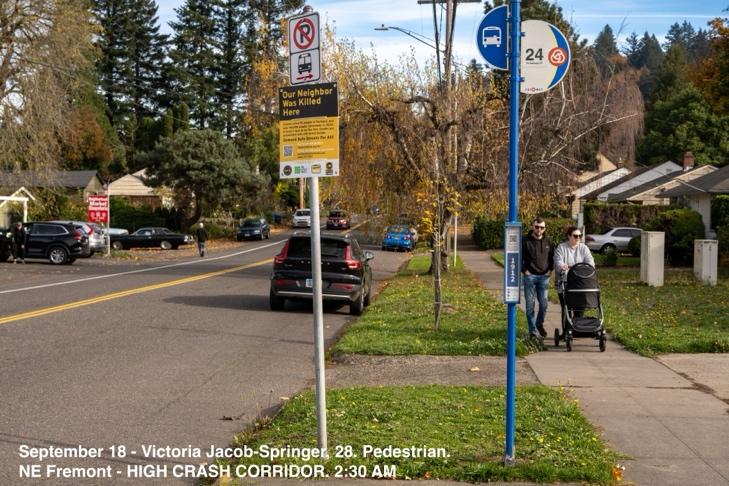
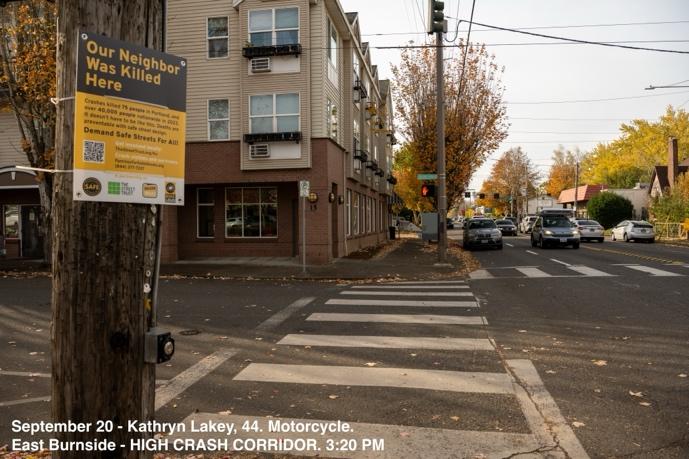
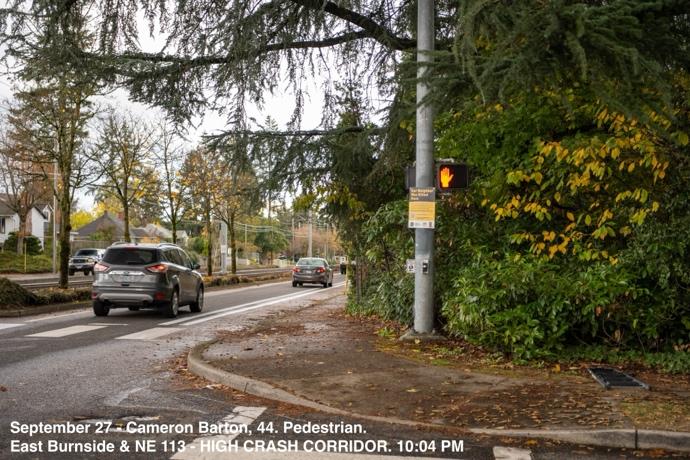
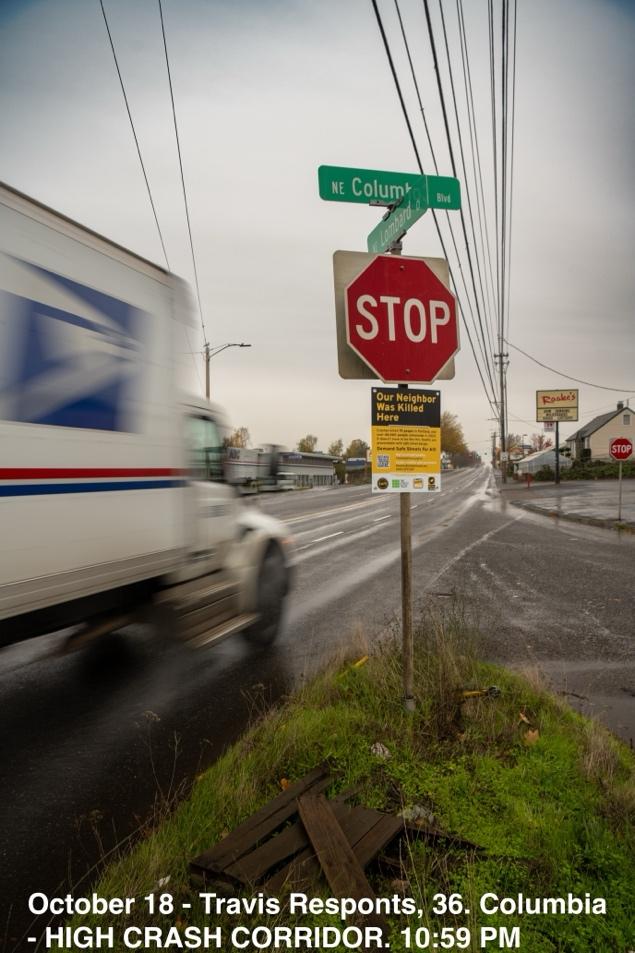
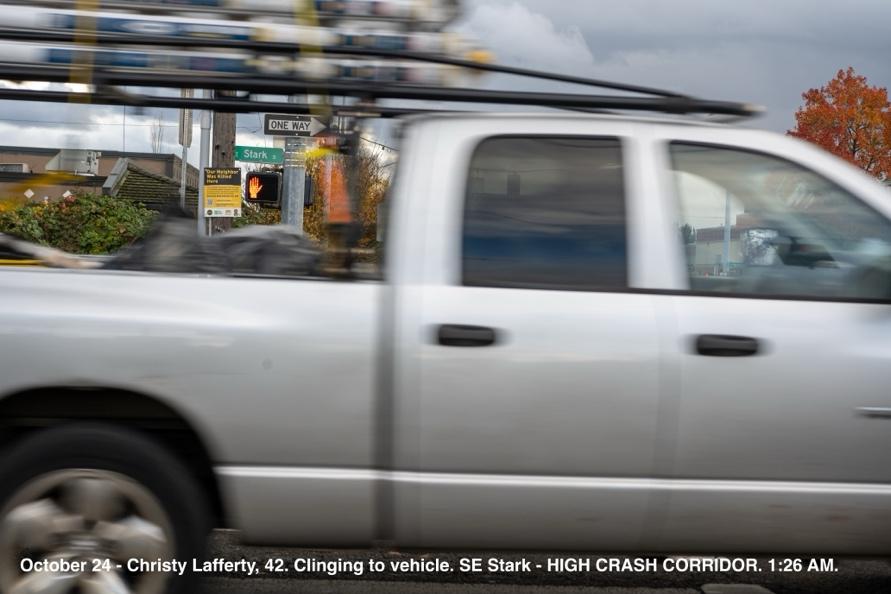
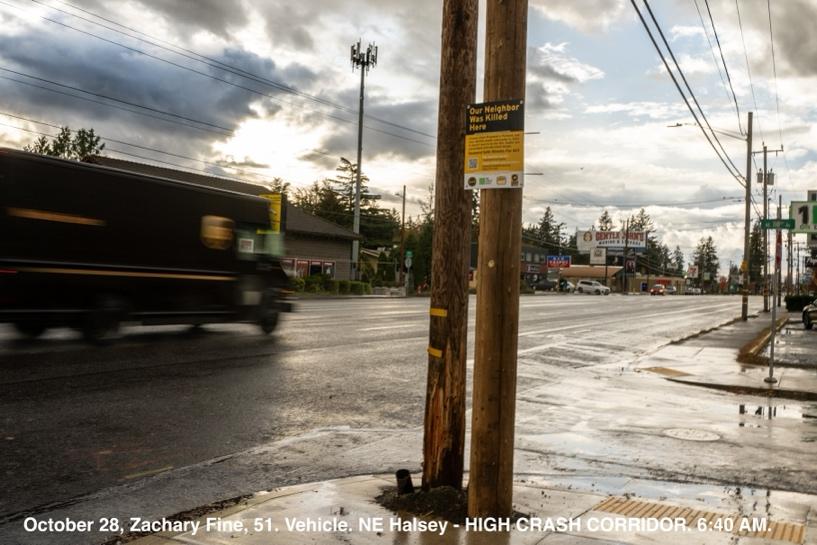
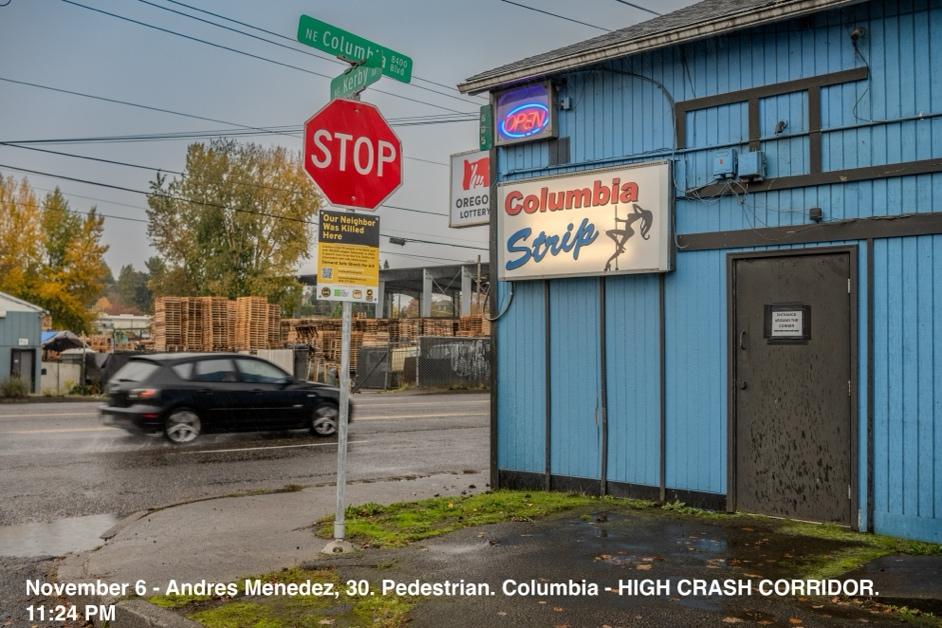

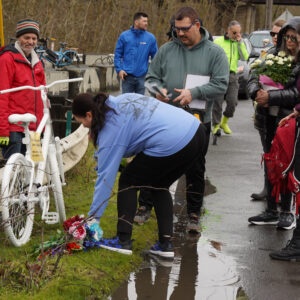
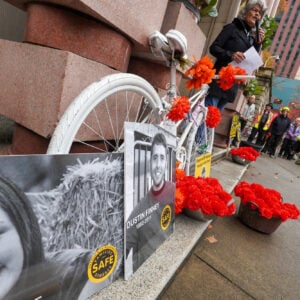

Thanks for reading.
BikePortland has served this community with independent community journalism since 2005. We rely on subscriptions from readers like you to survive. Your financial support is vital in keeping this valuable resource alive and well.
Please subscribe today to strengthen and expand our work.
Thank you for doing this Sarah.
I knew one of the people who was killed on our streets last year. I wasn’t super close with them, but I often talked to them on the bus or around my old neighborhood. They always had the same large Plaid Pantry coffee and would always complain about how bad the Plaid coffee was. We would talk about the weather, the lottery, and of course the shitty coffee. They were killed by a driver while walking in a crosswalk. The place where they were killed is a place that I bike through every day to get to and from work. I went by there only an hour after it happened. The police were still there.
It really hit me to have a member of my community ripped away like that, seemingly at random. I can only imagine the turmoil their family is going through. That spot is a constant reminder to me that there is no acceptable road fatality number above zero.
I grew up in a town of 10,000 people. My entire hometown gets killed four times over every year in this country.
Perhaps the biggest irony of your project is that the signs are too small to be read by drivers speeding by – perhaps the people who need to see them the most.
Stay safe out there everyone.
Could very well be the COTW – and also Sarah’s story could Story of the Year.
Thank you for doing this important work and bringing visibility to these tragedies.
Hi Sarah, I truly admire your dedication to honoring those lost in traffic fatalities and raising awareness about safety. However, I wanted to make sure you’re aware of some legal and safety concerns with putting signs on telephone poles in Portland.
Legal IssuesIn Portland, it’s generally prohibited to affix signs, posters, or other materials to utility poles. This falls under Portland City Code 14A.50.070 (“Posting of Signs on Public Property”) and could result in fines or removal of the signs. Additionally, utility companies have their own restrictions, as poles need to be kept clear for maintenance and safety.
Safety Concerns:
Worker Safety: Utility workers climb poles for maintenance. Nails, staples, or adhesives used for signs can injure them or interfere with their equipment.Public Safety: Signs can block visibility for drivers, cyclists, and pedestrians, especially near intersections or crosswalks.Pole Integrity: Over time, signs can damage poles, weakening their structure or increasing fire risks.Litter Problem: Signs eventually fall off poles and become litter, contributing to Portland’s already significant trash problem. This can worsen the city’s appearance and create additional cleanup work.Alternatives to Consider: There are many other meaningful ways to honor victims and spread awareness. You could:
Partner with local advocacy groups for traffic safety.Organize a community event or vigil.Work with the city to install permanent memorials or markers in safe, approved locations.If you’d like help brainstorming ideas or finding resources, let me know! It’s clear your heart is in the right place, and I’d love to help you make an impact without running into these issues.
I’m really sorry to see that a post that looks like it was written by ChatGPT is the first posted response. Yes, Sarah is no doubt breaking Portland City Code 14A.50.070, but if ever there was a case of misplaced priorities, this is it.
What an insensitive comment. People are dying in our streets and the only thing that concerns you is someone posting a memorial on a street pole?!?!
It is both hilarious and heartbreaking that a citizen responds to carnage on the roadways – largely caused by drivers not following the law – by suggesting that another citizen not violate the sign-hanging law, which hurts NO ONE.
There could be no better demonstration of the normalization of traffic carnage. “Oh dear – another person killed by a car. But look at how clean our poles are!”
For that matter, ghost bikes, political campaign signs, and Amazon delivery trucks are also illegal on city sidewalks, at least from 7 am to 9 pm.
It all boils down to enforcement and what the community is willing to tolerate.
Hi Mary, if there was ever a need for a freedom fighter to save lives, this is the time. Maybe you could recognize that?
If there was ever the definition of a victimless crime this is it
This screed was generated by AI and should be removed.
G’day Sarah, gotta say, I admire the effort to raise awareness about traffic deaths, but here’s the thing—Portland’s been setting records for traffic violence lately, and it’s not just a coincidence. The folks we’ve elected, along with groups like The Street Trust, have been all about reducing “racist” traffic enforcement and pushing an anti-cop narrative. Problem is, that’s resulted in a whole lot more people driving dangerously and more getting hurt on the streets. Sure, signs are nice, but maybe it’s time to ask whether we’re tackling the problem from the right angle. Traffic enforcement and the ending of unsanctioned camping might just be part of the missing pieces in making the streets safer for everyone, yeah?
This comment displays a ignorance of the topic at hand, a staggering ignorance of a century of traffic enforcement history, and also that you probably didn’t read that far before you scrolled down to make your comment. Your arguments are based on your own opinions. The dog whistles of “unsanctioned camping” and others indicate a lack of care for your community, probably motivated by fear of otherness.
Why don’t you just come out and say what you mean? Just say that you don’t care how many people are mowed down by cars on the street, as long as you can drive to work without any “traffic”. Just say that you want your tax dollars spent on more cops, fixing potholes, and widening freeways. You don’t care if keeping taxes low requires actual slave labor. You’re a homeowner and elected officials should listen to you, not some poor people who can’t even afford a car.
Just say the quiet part out loud, it saves the rest of us a ton of time and effort.
If you read what Sarah wrote, it should have been obvious that Sarah is well aware of the increase is traffic violence, well aware of the many reasons for it, well aware that there are solutions beyond blaming “anti-cop” politicians and organizations, and well aware that the signs she places aren’t a substitute for other actions.
Your comment seemed condescending, especially your “here’s the thing” and your “yeah?” at the end.
How do we stop these dangerous street takeover events if we can’t use police?
I’m just curious about potential solutions, because several of the deaths here are due to those events, even without police involvement.
I agree Chris I. I think it’s important for the police to break up street takeover events. But engaging in a high-speed chase from the scene increases the danger.
Thank you for doing this Sarah!
Thank you for this, Sarah.
I loved your photos Sarah, very nicely laid out, it felt like a tour of Portland (the good, the bad, and the ugly), and I even recognized a lot of street corners from my living there and biking all over the city (1997-2015).
I note that the vast majority of crashes were during the dark, reminding me of how poorly Portland (and most other cities) are lit at night even on high-crash stroads. Here in NC we also have a lot of poorly lit stroads, plus lots of drivers not turning on their headlights at night long after it’s gotten dark.
A general question for y’all: How common is it for night-time car drivers in Portland to be driving without their headlights on?
The collected location photos have some strong messages.
Many show poor conditions for walking, biking or even driving. They look like allowing someone to walk or bike safely was the last thing on anyone’s priority list, after things like convenient placing of utility poles. It’s a reminder how mundane and poorly considered/designed much of our environment is for the basic need of getting around.
But along with those are places that look somewhat safe and even pleasant. If you’re like me, you also recognize several locations, including a few you pass through often. It reminds me of what Ted Bundy said about killers. People expect them to look like monsters, but they don’t–they’re your relatives, your co-workers, totally unremarkable people. Similarly, a place doesn’t have to shout out, “This street is dangerous” to be dangerous.
As others have said, thank you, Sarah, for doing this impactful work.
I was surprised by how familiar I was with most of depicted locations. Somehow, I have missed several of the depicted signs, despite traveling past them. It’s sobering to face the fact that people are dying where I live and move.
Thanks for doing this Sarah, I really admire your dedication. I’ve been following an account called “Bike Lane Uprising” based in Chicago for years now, and they do ghost bikes and other memorials and have talked about the toll it’s taken on them. Each person killed in traffic violence has a story, and people who love them and the act of acknowledging that is deeply meaningful, but make sure that you find time and space to unpack and heal as well.
It takes dedication to absorb and communicate the cumulative tragedies on our streets. Thank you for making these awful losses visible to the otherwise unknowing public.
My boyfriend was killed in a hit & run on his motorcycle on SE 148th and Powell in spring of 2020. Thank you for your work on memorializing these spots, Sarah
Thank you for memorializing the year’s fatal traffic incidents and writing about the experience!
Seeing these signs at crash sites has been eye opening for some of my acquaintance. I didn’t realize until now that one person was installing them all! I get overwhelmed by the emotional weight of these deaths when simply reading about them. I can’t imagine the fortitude it takes to visit all of the sites.
Although I get around almost exclusively by bicycle or on foot, crash stories scare my family into insisting I should change to a mode that is less vulnerable. I am equally insistant that we not give in to the fear created by these scary anecdotes, especially scary when joined together like this. The temptation is to hide away from the danger, but what kind of life would that leave? We must look at our fears closely and not give in to irrational conclusions. This article and the signs remind us we can be better to our fellow humans, our neighbors. Thanks for that.
I am surprised by a couple of items in the article.
Speed is a factor in over 30% of all fatal crashes. Isn’t that rather closer to 100%? I must not understand what the 30% is derived from or points to, because it seems that without the speed of a vehicle there would be no crash at all ever.Homicide by vehicle is not included in the fatality statistics we use to measure the safety of our streets. Huh. Too wonky to make sense to me. Is this so we can say we want to address only deaths we may call accidental, in which the transportation authority is responsible for the unsafe conditions rather than or as much as the drivers who operate a multi-ton death machine in a manner that unsurprisingly causes a death?
I agree with you. I too believe that – ultimately – speed is a factor in every single fatality. I am sharing ‘official’ statistics. There is a law in every US state requiring drivers to adjust speed down for adverse conditions. IMO darkness, poor visibility, likelihood of pedestrians and cyclists sharing the road are all conditions that should cause drivers to slow down. Most people don’t realize that as many – if not more – are killed on Portland’s roads while inside of a vehicle. Statewide in-vehicle fatalities make up the greatest share – by a significant margin – of all road fatalities. Some perspective to share. Cyclists are a very small percentage of all road fatalities in Portland. Pedestrian and in vehicle fatalities were about the same in 2024
Don’t forget wet pavement, which is present extremely often in the PNW, and reduces traction!
When they say “speed is a factor” they don’t mean it in the most literal sense (they could just as easily say gasoline was a factor if they want it to be overly literal), they mean it in the sense everyone would understand it — speeding was a causative factor in the crash.
Ok, apologies here for pursuing the semantics, but I have trouble with the idea that “everyone” should understand what “they” (the officials who provide these official statistics) mean when they say “speed is a factor”. By “speeding” what does Watts think “everyone” understands? Does “speed” here simply mean “exceeding the posted speed limit” or something more nuanced like “exceeding the safe rate of travel, which can be found by adjusting downward from the posted speed limit by accounting for less-than-optimal conditions of light and weather and presence of vulnerable road users.” By that definition, you can be driving 25 mph in a zone posted for 25 mph but still be “speeding” if fog or dark or other conditions would make some elusive “reasonable” person agree that one should slow down. Or is the definition of the phrase “speed is a factor” in these statistics even more convoluted than that? Wonky, I believe Duncan said, which I think is a reference to the specialized jargon that actually is easily misunderstood by anyone not in the small group of people in the know. So, serious question: to what does the 30% actually refer, and how does that statistic help us put things in perspective.
I think if a road is icy and someone is blasting through at an obviously usafe speed, even if below the does limit, that would reasonably get called out. Safe speed is hugely variable… Equipment, driver skill, alertness, level of distraction, judgement, etc. It can’t be codified; it will always be a matter of judgement.
Thank you, Sarah. Road violence has been far too commonplace for far too long, and I appreciate the efforts of everyone who works to remind us. This is important work and it is heavy – thank you for your hard work and dedication.